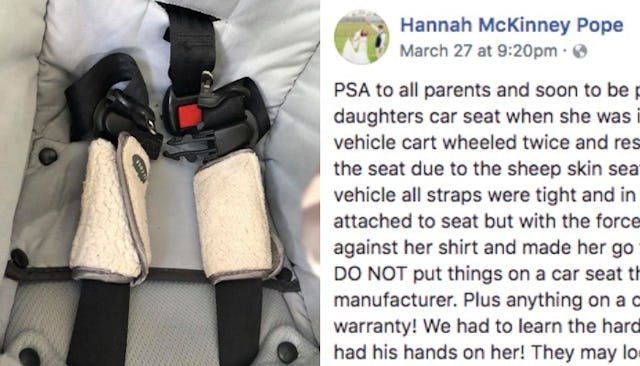Mom's Viral Post Highlights The Dangers Of Aftermarket Car Seat Accessories

Just because they sell car seat accessories doesn’t mean they’re a good idea–or even safe
Outside of Atlanta, Georgia, Hannah McKinney Pope’s two-month-old baby girl, Robin Pope, was in a van with her aunt when the vehicle was involved in an accident. It flipped, back to front, twice. The baby was ejected from her car seat and thrown to the back of the car, suffering a hairline fracture in her arm and a few cuts but, amazingly, no more serious injuries.
After the accident, Pope was shocked to learn that her baby was likely ejected from her car seat because of two aftermarket sheepskin harness covers: the covers likely pushed down the position of the baby’s chest buckle and were also slick enough to aid the ejection.
She shared her story on Facebook, where it quickly tallied almost 140,000 shares as her message about aftermarket carseat products spread.
She wrote, in part: “Please please please people DO NOT put things on a car seat that did not come that way from the manufacturer. Plus anything on a car seat in a accident voids the warranty! We had to learn the hard way and I thank god everyday that he had his hands on her! They may look cute and it may be soft but for your child’s safety don’t do it.”
Pope makes two very important points in her post: aftermarket car seat accessories can make the car seat less safe, and using them can also void the warranty, which means that in the event of an accident, it will be much more difficult to prove the car seat is defective, get a car seat reimbursement/replacement, or sue the carseat manufacturer.
Many new parents assume that just because car seat products are legally sold in stores, they’re safe for use, but this is often not the case. Car seats are developed and tested in extremely specific ways, and adding to or changing their design may also change their function.
The Car Seat Lady delves deeply into this topic, specifically outlining the dangerous of “fluff,” that is, anything that you add to your car seat that did not come in the box with the car seat, with the exception of your kid. Fluff, which consists of everything from harness covers to swaddlers to snow suits, can seriously effect your car seat’s effectiveness because:
- Fluff can make your harness straps too loose.
- Fluff can change the way your harness sits on your child.
- Fluff can cause ejection during a crash.
At Autobytel.com, Annie King ran down a list of seven different aftermarket products that could lower or eliminate the effectiveness of your kid’s car seat. They include:
- Harness covers, which can change the position of your baby’s chest buckle and which can alter the effectiveness of the harness.
- Head rests, which can change the position of your baby’s head and effective it’s head movement in the event of a crash.
- Newborn body swaddlers, which can change the position of your baby in its seat and increase the chance of ejection.
- Car seat swaddlers/covers, which can alter the installation of your car seat.
- Attachable toys and mirrors, which can quickly turn into projectiles in the event of a crash (or even a sudden stop).
- Seat protectors, which can alter the installation of the car seat base.
- Car seat angle adjusters, which can alter the installation of the car seat base.
Pope was interviewed by WSB-TV Atlanta, where she told her story and met with a car seat safety expert to spread the word about aftermarket car seat accessories.
“You never want to add anything to a car seat that doesn’t come with it. It’s not crash tested with the car seat,” Children’s Healthcare of Atlanta child safety expert Johanna Martinez said in the video.
The best action to take with car seats is to always read all of the directions (and the warranty) before using and installing it, even if you think everything is self-explanatory. It also doesn’t hurt to take your seat in for a professional inspection–many places, like fire stations, offer these inspections for free. Finally: be sure to register your car seat so that you receive recall information in the event that a defect is found.
This article was originally published on